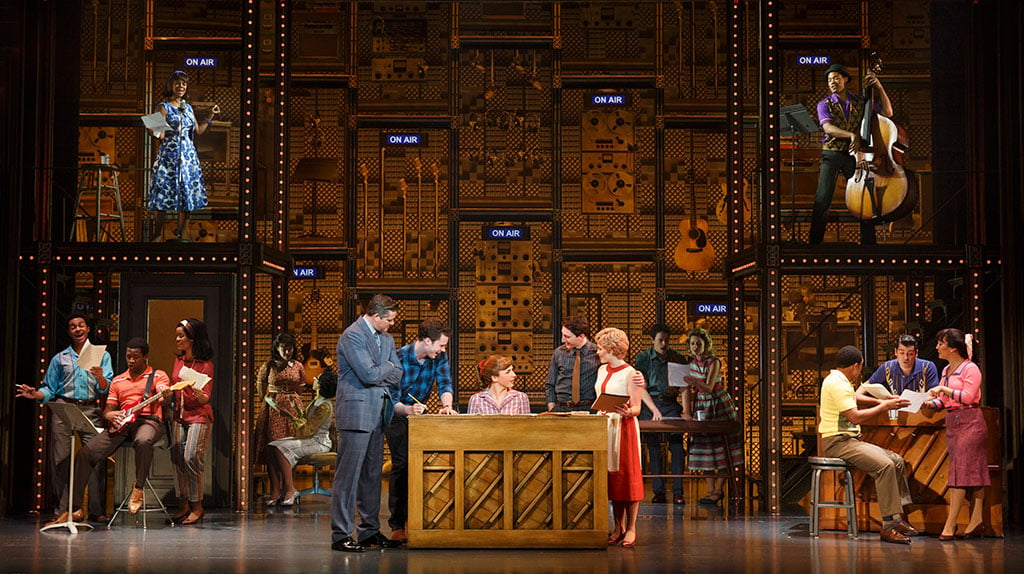
The musical “Beautiful,” about the life and songs of Carole King, visits Walton Arts Center through Sunday.
Courtesy photo
How well do you know the story behind your favorite album? Not what the songs mean to you, or what the artist who recorded it might have said once in an interview. What do you really know about the people who made it, and how difficult the process of creating art can be?

What: “Beautiful: The Carole King Musical”
When: Through April 29
Where: Walton Arts Center, Fayetteville
Cost: $57-$108
Tickets: 479-443-5600 or tickets.waltonartscenter.org
This question is the one asked by “Beautiful,” the musical about the life and songs of Carole King. The show is currently still on Broadway, debuting there in January 2014. The touring version of the Broadway hit visits Fayetteville for an eight-show run that started Tuesday (4/24) and continues through Sunday at the Walton Arts Center.
King, as the plotline in “Beautiful” tells us, was part of a chart-topping songwriting duo before breaking into the industry as a solo artist. Her best-known album, “Tapestry,” is a lot of people’s favorite album, and for good reason. It’s a tremendous collection of songs.
Depending on how well you know the music industry or perhaps your age, you might know less about King’s early career as a teenaged songwriting prodigy. With assistance from her husband Gerry Goffin, who she met and married while still in college, the duo churned out a series of pop hits in the 1960s. Who knew that King and her husband wrote “The Locomotion” in 1962? I sure didn’t. The couple had already long established their credentials by then. The duo scored their first hit two years earlier with “Will You Love Me Tomorrow,” which topped the charts in 1960 when it was recorded by The Shirelles. King was just 18 at the time.
The success of that song allowed Goffin and King to get a place on their and focus on songwriting full time. They became part of the music-making factory called the Brill Building school of songwriting, which featured songwriters such as Neil Sedaka, Phil Spector and Paul Simon. Their songwriting collective also included the duo of Barry Mann and Cynthia Weil. Their presence becomes a side plot to the King-Goffin story, with Mann and Weil serving as best friends and competitive rivals to Goffin and King. That broadens the collection of songs in the musical in a smart way, providing access to Mann and Weil hits such as “On Broadway” and “You’ve Lost That Lovin’ Feeling.” You’ll recognize a lot of the songs included in “Beautiful,” and perhaps you’ll be surprised that King had a hand in so many, like I was.
In an interview about “Beautiful,” the real-life Barry Mann described their roles as the Fred and Ethel to Goffin and King’s Desi and Lucy.
It was ultimately Lucy’s show, and “Beautiful” became the Carole King show, which means the touring version in Fayetteville is the show of actress Sarah Bockel, who has the daunting task of bringing King and her stories to life. The script presents King as an ace songwriter but a reluctant performer. Meanwhile, any actress in the lead role in this musical must bring humanity to King’s silly pop songs while also developing the footing and confidence to compose her own emotionally deeper material. As a vehicle for watching strong performances, “Beautiful” works. As a peek behind the scenes of the creative process, we’re left wanting, as songwriting is reduced here to a paint-by-numbers approach. We don’t see the songs that didn’t work, and we see very little of the toil involved in the process. We’re instead led to believe that in a matter of hours King writes the songs, Goffin writes the lyrics and a song jumps up the charts. It is simultaneously one of the charms and problems with jukebox musicals – we get to see a lot of hits, and the early works of King and Goffin are dutifully included. But what strings these numbers together leaves something to be desired.

King and her co-writer Gerry Goffin had a string of chart-topping songs, including “Up on the Roof,” which was made into a hit by The Drifters. In the musical “Beautiful,” the ensemble re-creates many such acts, including The Drifters.
Courtesy photo
With fewer songs and the dramatic turn for the evening closing out the first act, the second half of the production clicks along and becomes more fulfilling than its predecessor. The capacity crowd at the Walton Arts Center on Tuesday got behind King’s breakaway into a solo artist to the point an audience member sitting behind me yelled – quite literally – for a character to leave the stage. She was that mad at anyone holding King back.
I wouldn’t go so far as to recommend talking loudly while in the theater. But if you want to hear a dozen pop hits from the 1960s and 1970s, I think you’ll root for Carole King, too.

